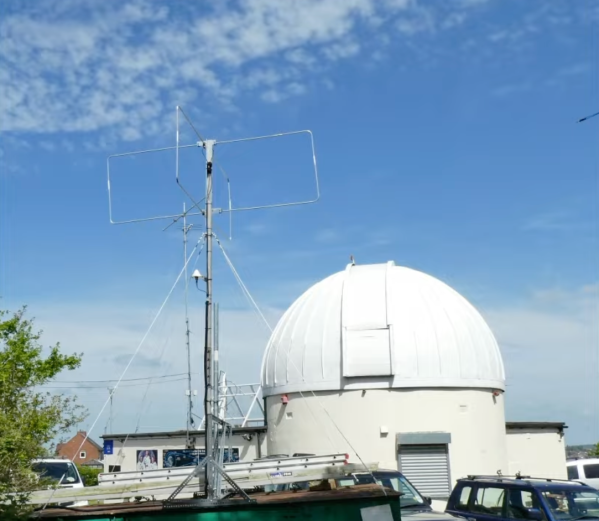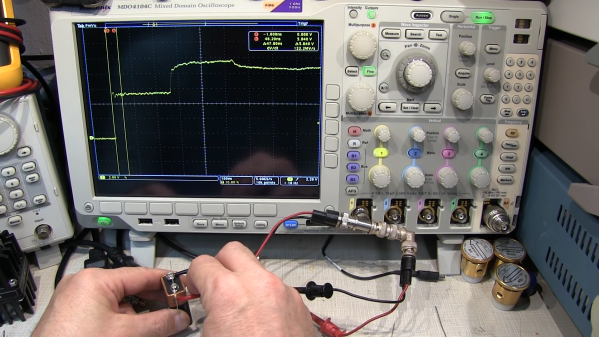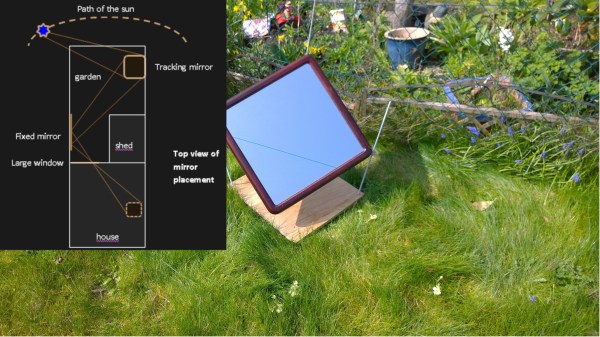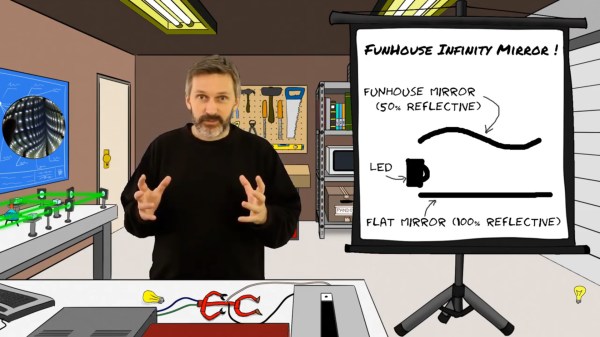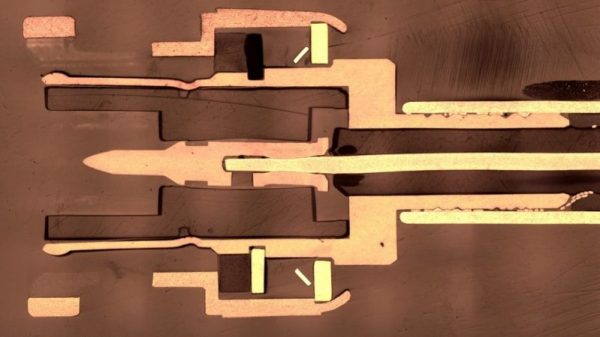Ho-hum — another week, another high-profile bricking. In a move anyone could see coming, Humane has announced that their pricey AI Pin widgets will cease to work in any meaningful way as of noon on February 28. The company made a splash when it launched its wearable assistant in April of 2024, and from an engineering point of view, it was pretty cool. Meant to be worn on one’s shirt, it had a little bit of a Star Trek: The Next Generation comm badge vibe as the primary UI was accessed through tapping the front of the thing. It also had a display that projected information onto your hand, plus the usual array of sensors and cameras which no doubt provided a rich stream of user data. Somehow, though, Humane wasn’t able to make the numbers work out, and as a result they’ll be shutting down their servers at the end of the month, with refunds offered only to users who bought their AI Pins in the last 90 days.
reflection16 Articles
Creating Temporal Light Reflections With Metamaterials
Owing to the wave nature of light there are many ways that such different waves can interact with each other, but also with materials. Everyone knows about reflecting light with a mirror, which is a property of materials like metals, but specific structures can cause the light to behave in a way that creates rather amazing results.
Examples of this are cases of iridescence in nature (like butterfly wings) and eye color, where the perceived colors are the result of environmental light interacting with these structures rather than pigmentation or dyes. An even more interesting interaction has now been demonstrated by reflecting multiple microwave radiation beams off each other, creating a time reflection.
The study by [Emanuele Galiffi] et al. (shared copy) was published in Nature Physics. By creating a metamaterial that allows for temporal coherent wave control (CWC) the electromagnetic radiation was controlled to where it allowed for this kind of unusual interaction. The key here being that there is no major constructive or destructive interaction between the two waves as with spatial CWC, rather the wave reflect off each other, or more specifically the time interface.
Although the popular reporting talks about ‘turning back time’ and ‘watching the back of your own head in a mirror’, the impact is far less dramatic: in the article conclusion the researchers mention unveiling new light-matter interactions in the microwave- and other parts of the spectrum, as well as new ways to control and shape light.
Top image: Temporal coherent wave control and photonic collisions enabled by time-interfaces. (Credit: Emanuele Galiffi et al., Nature Physics, 2023)
Hams Watch For Meteors
After passing an exam and obtaining a license, an amateur radio operator will typically pick up a VHF ratio and start talking to other hams in their local community. From there a whole array of paths open up, and some will focus on interesting ways of bouncing signals around the atmosphere. There are all kinds of ways of propagating radio waves and bouncing them off of various reflective objects, such as the Moon, various layers of the ionosphere, or even the auroras, but none are quite as fleeting as bouncing a signal off of a meteor that’s just burned up in the atmosphere.
While they aren’t specifically focused on communicating via meteor bounce, The UK Meteor Beacon Project hopes to leverage amateur radio operators and amateur radio astronomers to research more about meteors as they interact with the atmosphere. A large radio beacon, which has already been placed into service, broadcasts a circularly-polarized signal in the six-meter band which is easily reflected back to Earth off of meteors. Specialized receivers can pick up these signals, and are coordinated among a network of other receivers which stream the data they recover over the internet back to a central server.
With this information, the project can determine where the meteor came from, some of the properties of the meteors, and compute their trajectories by listening for the radio echoes the meteors produce. While this is still in the beginning phases and information is relatively scarce, the receivers seem to be able to be built around RTL-SDR modules that we have seen be useful across a wide variety of radio projects for an absolute minimum of cost.
Dead Simple Time-Domain Reflectometry With Just A Battery And An Oscilloscope
“Time-domain reflectometry” sure sounds like something that needs racks of expensive equipment to accomplish. In reality, TDR is just measuring the time between injecting a pulse into a cable and receiving its echo, either from the other end of the cable or from some fault or defect along the way. It’s a useful technique, and as [Allen Wolke (W2AEW)] shows us, it can be accomplished with little more than a battery, a resistor, and an oscilloscope. And a little math, of course.
There are, of course, dedicated time-domain reflectometers, but all of them are really just elaborations of the basic principles [W2AEW] demonstrates with his simple setup. The oscilloscope is set up with a tee connector on one channel; one side of the tee is connected to the cable under test, while the shield conductor of the other side is connected to the negative terminal of a 9V battery. A resistor connected to the center conductor is used to complete the circuit, which sends a brief pulse down the test cable. The scope is set up to capture the outgoing pulse as well as the return pulse, allowing the time between the two to be measured. Some simple math gives the length of the cable, the distance to a fault, or with a little rearrangement, the velocity factor of the cable.
The video below shows the simple method at work on coax and Cat 5e Ethernet cable. It even worked on a roll of zip cable, which was a little surprising. If this technique is too simple, you can always elaborate a bit and roll your own TDR tester. Googly eyes optional, of course, but recommended.
Continue reading “Dead Simple Time-Domain Reflectometry With Just A Battery And An Oscilloscope”
Skylight In Any Room
Despite a glut of introvert memes, humans need sunlight. If vitamin D isn’t your concern, the sun is a powerful heater, and it helps plants grow. Sadly for [mime], their house is not positioned well to capture all those yummy sunbeams. Luckily for us, their entry into the 2020 Hackaday Prize is their sun-tracking apparatus that redirects those powerful rays throughout the house. It uses a couple of mirrors to redirect the light around their shed and into the house. For those who work in a dim office, no amount of work is too great for a peek of natural sunlight.
Movie spoiler alert: We saw this trick in the 1985 movie Legend and it was enough to vanquish the Lord of Darkness.
This project started in 2014 and sat on hiatus for more than five years, but it is back and prime for improvements fueled by half-a-decade of experience. The parts that aren’t likely to change are the threaded struts that adjust the positioning mirror’s angle, the driving motors, and power circuitry. Their first plan was to build a solar-powered controller with an Arduino, DC motors, and sun telemetry data, but now they’re leaning toward stepper motors and a computer in the house with a long cable. They are a finalist this year, so we will keep our eyes peeled for further development.
Infinity Mirror At Warp Speed
Inventing often combines more than one old ideas into a new one. Even when the fused things are similar, the result can be more valuable than the sum of its parts. Unlike those analog watches with a digital clock below the face, when [Mojoptix] combined the re-reflecting properties of an infinity mirror with the image twisting qualities of a funhouse mirror, we get more than just a pair of mirrors. The resulting images look like a lot of fun. Warping one surface of two parallel mirrors doesn’t just alter the result a bit, because the planes feed off each other’s view, the final product is an exponentially skewed show.
Our host mounts a 3D printed ring with an hubward-facing strip of LEDs to an ordinary glass mirror. Over that, he designs four mated plates that hold semi-reflective film sheets in different shapes. The first is a hyperbolic paraboloid, but it’s probably easier to think of it as shaped like a Pringles chip (crisp). Once the light is applied, it looks like a bowtie made by a deranged god or the start of an infinite rabbit hole of light and reflection. To further the madness, he hits us with four shapes at once, so we hope you’ll take a moment to enjoy the video below.
This guy is no stranger to optics, and we’ve reported on a couple of other cool inventions that teach a concept through demonstration. His precision calipers demonstrate the Moiré effect, and his digital sundial capitalizes on parallel light beams.
The BNC Connector And How It Got That Way
When I started working in a video production house in the early 1980s, it quickly became apparent that there was a lot of snobbery in terms of equipment. These were the days when the home video market was taking off; the Format War had been fought and won by VHS, and consumer-grade VCRs were flying off the shelves and into living rooms. Most of that gear was cheap stuff, built to a price point and destined to fail sooner rather than later, like most consumer gear. In our shop, surrounded by our Ikegami cameras and Sony 3/4″ tape decks, we derided this equipment as “ReggieVision” gear. We were young.
For me, one thing that set pro gear apart from the consumer stuff was the type of connectors it had on the back panel. If a VCR had only the bog-standard F-connectors like those found on cable TV boxes along with RCA jacks for video in and out, I knew it was junk. To impress me, it had to have BNC connectors; that was the hallmark of pro-grade gear.
I may have been snooty, but I wasn’t really wrong. A look at coaxial connectors in general and the design decisions that went into the now-familiar BNC connector offers some insight into why my snobbery was at least partially justified.
Continue reading “The BNC Connector And How It Got That Way”



